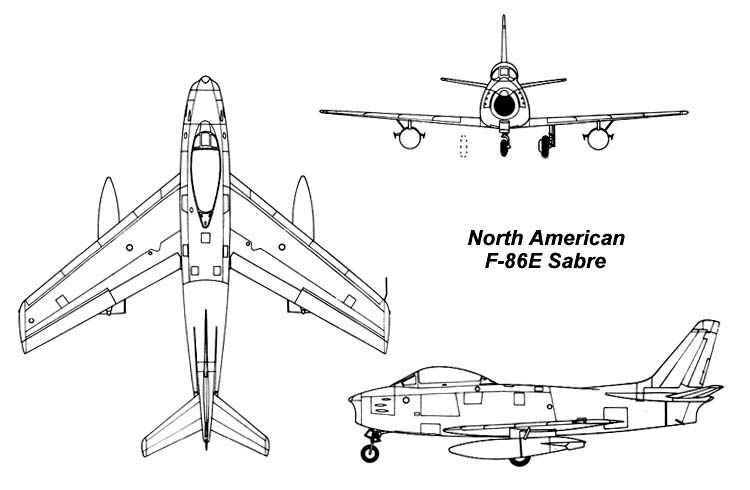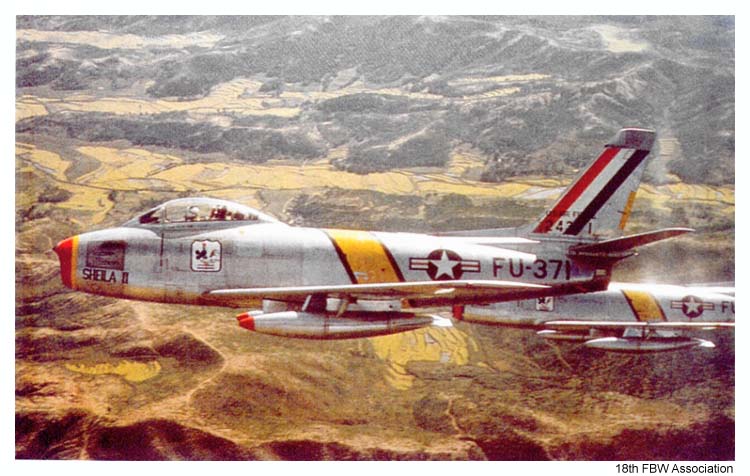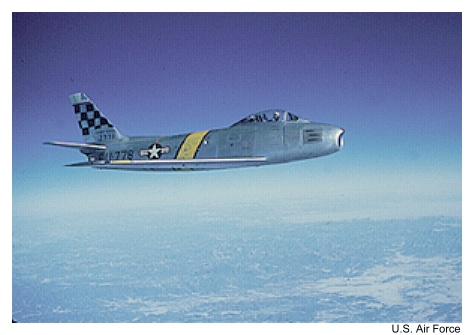Try Amazon Fresh

Find the perfect fit with Amazon Prime. Try Before You Buy.
North American F-86 Sabre

 Making its first flight
on October 1, 1947 with WWII triple-ace George Welch
at the controls, the XP-86 was the first manned aircraft to exceed the
speed of sound (in a dive). Typical of American early
jets, it initially suffered from being under-powered. Entering service
with the 4th Fighter Group in January of 1949, the F-86A
was rushed to Japan in the fall of 1950 to counter the Soviet made (and
frequently Soviet flown) MiG-15 after it made its appearance in the sky over Korea.
With the F-80 and F-84 being generally outclassed by the MiG, the risk
of losing control of the air over the battlefield became
a real possibility. Although never available in adequate numbers, the
Sabre re-established air superiority despite being outnumbered
by the MiGs by as much as 4 to 1. These Sabres were assigned to the 67th
Fighter-Bomber Squadron of the 18th Fighter-Bomber Wing. The
photo dates to the Spring of 1953.
Making its first flight
on October 1, 1947 with WWII triple-ace George Welch
at the controls, the XP-86 was the first manned aircraft to exceed the
speed of sound (in a dive). Typical of American early
jets, it initially suffered from being under-powered. Entering service
with the 4th Fighter Group in January of 1949, the F-86A
was rushed to Japan in the fall of 1950 to counter the Soviet made (and
frequently Soviet flown) MiG-15 after it made its appearance in the sky over Korea.
With the F-80 and F-84 being generally outclassed by the MiG, the risk
of losing control of the air over the battlefield became
a real possibility. Although never available in adequate numbers, the
Sabre re-established air superiority despite being outnumbered
by the MiGs by as much as 4 to 1. These Sabres were assigned to the 67th
Fighter-Bomber Squadron of the 18th Fighter-Bomber Wing. The
photo dates to the Spring of 1953.
 In terms of performance,
the F-86 held advantages in rate of roll, rate of turn, and maximum
speed below 30,000 feet. However, the MiG was clearly superior in climb
and acceleration. Perhaps, the greatest advantage of
the MiG was its higher ceiling. This allowed the MiGs to have the
advantage of altitude, which always translates into having
the initial tactical edge in any encounter. Moreover, the MiG pilots
could escape across the Yalu river should they find themselves
in danger of being shot down. Likewise, the Sabre pilots were able to
escape over the sea
as Soviet pilots were forbidden to pursue U.N. aircraft over water.
Armed with six .50 caliber Browning machine guns, the F-86 lacked the
hitting power of the MiGs with their three heavy, but slow firing
cannon. Unlike the U.S. Navy, the Air Force elected to refrain
from specifying the 20mm cannon. As a result, many MiGs survived hits
that would have been fatal had
the Sabre been fitted with the much more lethal 20mm weapons.
Read More About This Aircraft
In terms of performance,
the F-86 held advantages in rate of roll, rate of turn, and maximum
speed below 30,000 feet. However, the MiG was clearly superior in climb
and acceleration. Perhaps, the greatest advantage of
the MiG was its higher ceiling. This allowed the MiGs to have the
advantage of altitude, which always translates into having
the initial tactical edge in any encounter. Moreover, the MiG pilots
could escape across the Yalu river should they find themselves
in danger of being shot down. Likewise, the Sabre pilots were able to
escape over the sea
as Soviet pilots were forbidden to pursue U.N. aircraft over water.
Armed with six .50 caliber Browning machine guns, the F-86 lacked the
hitting power of the MiGs with their three heavy, but slow firing
cannon. Unlike the U.S. Navy, the Air Force elected to refrain
from specifying the 20mm cannon. As a result, many MiGs survived hits
that would have been fatal had
the Sabre been fitted with the much more lethal 20mm weapons.
Read More About This Aircraft
Return To Main Page: The Air War Over Korea

Unless otherwise indicated, all articles Copyright © Corey C. Jordan 2001.
Reproduction for distribution, or posting to a public forum without express
written permission is a violation of applicable copyright law.





